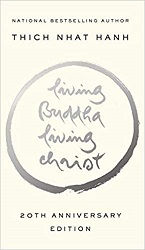
 Living Buddha, Living Christ
Living Buddha, Living ChristReview posted May 9, 2020.
Riverhead Books, 1995. 208 pages.
Review written August 17, 2019, from a library book
Starred Review
A big thank you to my friend who recommended this book to me. (Actually, he mentioned it as if I would have read it. I checked it out.) It ended up fitting nicely with another book I was reading, The Universal Christ, by Richard Rohr.
In this book, Thich Nhat Hanh, a Buddhist monk, looks at the wisdom that Christians and Buddhists can get from each other’s traditions and teachings.
He talks about his own encounters with Christians who embody the teachings of Jesus. He sees the coming together of people from different religions as the work of peace. This book explains many of the things we have in common.
Here are some thoughts from the first chapter:
When you touch someone who authentically represents a tradition, you not only touch his or her tradition, you also touch your own. This quality is essential for dialogue. When participants are willing to learn from each other, dialogue takes place just by their being together. When those who represent a spiritual tradition embody the essence of their tradition, just the way they walk, sit, and smile speaks volumes about the tradition.
In fact, sometimes it is more difficult to have a dialogue with people in our own tradition than with those of another tradition. Most of us have suffered from feeling misunderstood or even betrayed by those of our own tradition. But if brothers and sisters in the same tradition cannot understand and communicate with each other, how can they communicate with those outside their tradition? For dialogue to be fruitful, we need to live deeply our own tradition and, at the same time, listen deeply to others. Through the practice of deep looking and deep listening, we become free, able to see the beauty and values in our own and others’ tradition.
To be honest, I’m not sure I understood a lot of what was said in this book. But I was challenged, and some new ideas were presented to me. I do believe that some of these ideas can deepen my own faith.
Here’s an example of a section that challenges me to live out what I believe in community:
The church is the vehicle that allows us to realize those teachings. The church is the hope of Jesus, just as the Sangha is the hope of the Buddha. It is through the practice of the church and the Sangha that the teachings come alive. Communities of practice, with all their shortcomings, are the best way to make the teachings available to people. The Father, Son and the Holy Spirit need the church in order to be manifested. (“Wherever two or three are gathered in My Name, there I am.”) People can touch the Father and the Son through the church. That is why we say that the church is the mystical body of Christ. Jesus was very clear about the need to practice the teaching and to do so in community. He told His disciples to be the light of the world. For a Buddhist, that means mindfulness. The Buddha said that we must each be our own torch. Jesus also told His disciples to be the salt of the world, to be real salt. His teaching was clear and strong. If the church practices well the teachings of Jesus, the Trinity will always be present and the church will have a healing power to transform all that it touches.
It was good for me to admit and realize that I can learn spiritual truths from a Buddhist. And there’s much to learn in this book.
